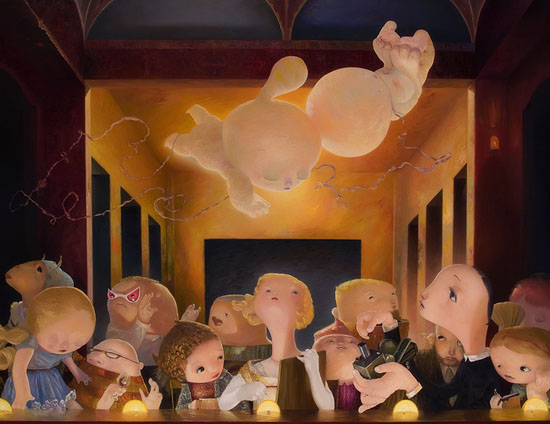Speartalks: Joe Sorren

There are people in the paintings of Joe Sorren, but they’re not quite human. We have ways to relate — they hold instruments, they take pictures, they build sand castles by the sea — but there is something in them that is not like us.
I have always felt that the occupants of the world of Joe Sorren are more innocent than those in mine. Their hands may be the size of heads, their heads the shape of balloons, but in all of their twists and distortions, their eyes are sources of infectious calm.
Sorren’s work has appeared in publications as varied as Rolling Stone, Print and The L.A. Times, and is a part of many significant collections worldwide. Universally loved and lauded, you’d do well to be aware of the work of this Arizona-based artist.
Joshspear.com: You didn’t start painting until 1991, when you were already out of your teens. Did you pursue anything else creatively up until that point, or was art something you only discovered in college?
Joe Sorren: I was one of those kids who always drew on everything, and goofed around in music, but I always felt intimidated by painting until I tried it in college. Once I did it was all I wanted to do. I love the fact that all bets are off when you paint; the idea that anything can happen captivates me.
JS.com: What was the path of pursuing art as a career like?
JS: After college, I flipped burgers up in Oregon and painted as much as I could. Then, after a freak interview, I worked as an art director for Transworld Snowboarding Magazine and Ride Snowboards for about a year. After a year or so I left those jobs to paint full-time. I took on illustration jobs, private commissions and gallery shows to make ends meet — just tried to give myself the opportunity to paint as much as possible. That is the way I have always liked to approach my career in art. When I find some success, I see it as buying more time to keep painting.
JS.com: You live in Flagstaff, AZ, where the art that seems to receive the most attention is often organically themed and inspired by romanticized history. How did you find you’re niche in lowbrow art after spending so much time in this environment?
JS: I have never really paid too much attention to the art happening around me. I feel that if I see something contemporary that has a cool idea I would not be able to do it — just for already seeing it done. But if I don’t know about it, I can explore it without knowing how others have approached it.

JS.com: Have you always been a sculptor as well, or was that something you experimented with later in your career?
JS: I was all 2D until 2002, when I started playing around with sculpture. It is an ongoing experiment.
JS.com: The subjects of your paintings are so unexpected – monsters making toast, glowing babies floating above a dinner table. Where do your concepts come from?
JS: I usually enter a painting with no ideas, and just begin applying paint to see what arrives. I find art to be most engaging when I am surprising myself. As long as I stay open for whatever to arrive, anything can show up for dinner.
JS.com: You’ve taken on some big, time-consuming projects, like the mural in Heritage Square in Flagstaff that took you nine months to complete. What drives you to take on these huge endeavors?
JS: Soooo fun. It’s just a blast to be presented with something so big, and to wrap your head up in that world for an extended piece of time. Getting back to the last question about ideas; the mural was like that, just painting and being open. Sort of like doing picture puzzles in the dark.
JS.com: You’re work often takes on music as a theme. What are you trying to share with those pieces?
JS: My love of sound, of timbre.
JS.com: In an interview you did a while back with Mike Buchheit, you mentioned that your walls at home are bare. Is this still the case, and if so … why?

JS: Yup. I just can’t not look if things are there. It is overly influencing and distracting. Kind of like how the doctor who … no, like the butcher who can’t stand … hmmm, it’s like how the butcher’s doctor doesn’t ask for extra chops for the freezer or something. It’s too distracting; I just don’t like it. That made no sense. Har.
JS.com: When you feel that you’ve finished a piece, are you critical of it, or do you have a more peaceful relationship with your paintings?
JS: I always ask myself, “Have I done the best I can do?” If so, I move on. If not, I ask, ‘Where?’ and re-approach it accordingly. It is an easy pitfall for artists to feel immediately nostalgic about a piece they have just finished, I think. But it can also act as a blinder for the next painting if you’re not careful. I find I need some distance between myself and a painting to see it the way it feels.
JS.com: What are you currently working on and working towards?
JS: I am currently playing with a few sculpture ideas and working towards my next show in the fall of 2009.
